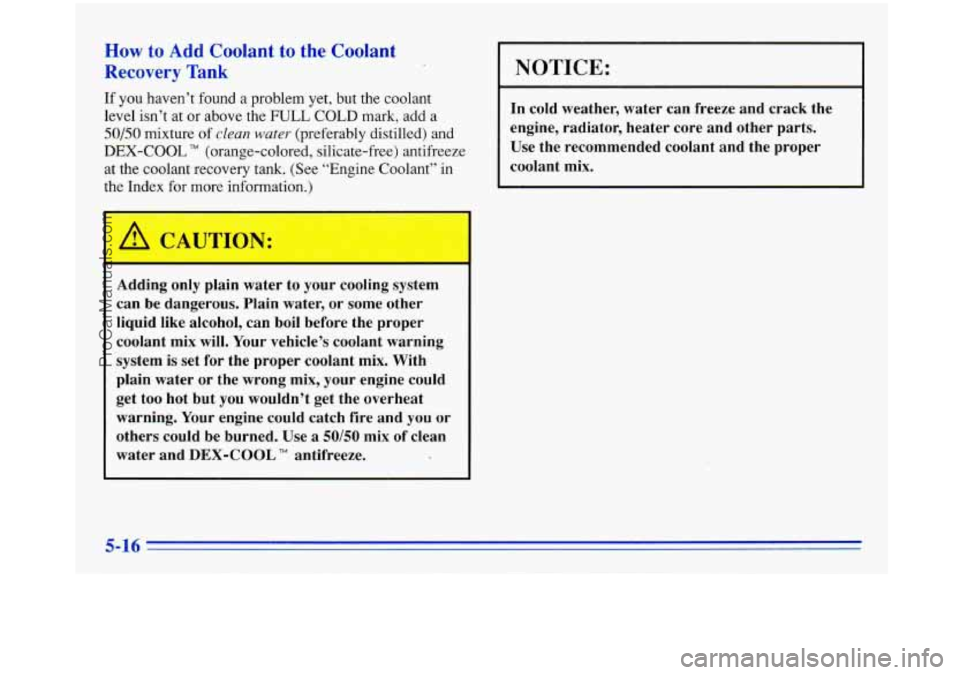Page 226 of 388
When you decideit’s safe to lift the hood, here’s what
you’ll see:
An electric fan under the hood can start up even
when the engine is not running and can injure
you. Keep hands, clothing and tools aw~ay from
any underhood electric fan.
If the coolant inside the coolant recovery tank is boiling,
don’t
do anything else until it cools down.
A. Coolant Recovery Tank
B. Radiator Pressure Cap
C. Electric Engine Fans
5-14
.I .
ProCarManuals.com
Page 227 of 388
The coolant level should be at or above the FULL
COLD mark. If it isn't, you may have a leak in the
radiator hoses, heater hoses, radiator, water
purnp or
somewhere elsC
in the-cooling system..
I A CAUTION:
I
Heater and radiator hoses, and other engine
parts, can be very hot. Don't touch them.
If you
do, you can be burned.
Don't run the engine
if there is a leak. If you run
the engine, it could lose all coolant. That could
cause an' engine fire, -and you could be burned.
Get any leak fixed before you drive the vehicle.
I NOTICE:
Engine damage from running your engine
without coolant isn't covered
by your warranty.
If there seems to be no leak, with the engine on, check to
see if the electric engine fans are running.
If the engine
is overheating, both fans should be running.
If they
aren't, your vehicle needs service.
5-15 ,
ProCarManuals.com
Page 228 of 388

How to Add Coolant to the Coolant
Recovery Tank
If you haven’t found a problem yet, but the coolant
level isn’t at or above the FULL COLD
mark, add a
50/50 mixture of clean water (preferably distilled) and
DEX-COOL
TM (orange-colored, silicate-free) antifreeze
at the coolant recovery tank.
(See “Engine Coolant” in
the Index for more information.)
Adding only plain water to your cooling system can be dangerous. Plain water, or some other
liquid like alcohol, can boil before the proper
coolant
mix will. Your vehicle’s coolant warning
system
is set for the proper coolant mix. With
plain water or the wrong mix, your engine could
get
too hot but you wouldn’t get the overheat
warning. Your engine could catch fire and you
or
others could be burned. Use a 50/50 mix of clean
water and
DEX-COOL TM antifreeze.
I NOTICE:
In cold weather, water can freeze and crack the
engine, radiator, heater core and other parts.
Use the recommended coolant and the proper
coolant mix.
5-16
ProCarManuals.com
Page 229 of 388
I A CAUTION:
r
You can be burned if you spill coolant on hot
engine parts. Coolant contains ethylene glycol
and it will burn if the engine parts are hot
enough. Don’t spill coolant on a hot engine.
When the coolant in the coolant recovery tank is at or
above the
FULL COLD mark, start your vehicle.
If the overheat warning continues, there’s one more
thing you can try.
You can add the proper coolant mix
directly to the radiator but be sure the cooling system is
cool before you do it.
5-17
ProCarManuals.com
Page 232 of 388
I
3. Fill the radiator with the proper mix, up to tffe base
of the filler neck. 4. Then fill the coolant recovery tank to the FULL
5. Put the cap back on the coolant recovery tank, but
COLD mark.
leave the radiator pressure cap
off.
5-20
ProCarManuals.com
Page 233 of 388
6. Start the engine and let it run until you can feel the
upper radiator hose getting hot. Watch out for the
engine fans.
7. By this time the coolant level inside the radiator
filler neck may be lower.
If the level is lower, add
more of the proper mix through the filler neck until
the level reaches the base
of the filler neck.
8. Then replace the pressure cap. At any time during
this procedure if coolant begins to
flow out of the
filler neck, reinstall the pressure cap. Be sure the
arrows
on the pressure cap line up like this.
ProCarManuals.com
Page 256 of 388
NOTICE:
If you need a new cap, be sure to get the right
type. Your dealer can get one for
you. If you get
the wrong type, it may not fit or have proper
venting, and your fuel tank and emissions system
might be damaged.
Checking Things Under the Hood
I
I
An electric fan under the hood can start up and
injure you even when the engine is not running.
Keep hands, clothing and tools away from
any
underhood electric fan.
I
Things that burn can get on hot engine parts and
start
a fire. These include liquids like gasoline,
oil, coolant, brake fluid, windshield washer and
other fluids, and plastic or rubber.
You or others
could be burned. Be careful not to drop or spill
things that will burn onto
a hot engine.
Hood Release
ProCarManuals.com
Page 258 of 388
wv DCIIC~ II [~uut: n) u~gmc (L36)
When you open the hood on the 3800 (L36) engine, here’s what you will see:
A. Engine Coolant Surge Tank
B. Battery
C. Radiator Pressure Cap
D. Engine Oil Dipstick E.
Oil
Fill Cap
E Automatic Transaxle Fluid
Dipstick
G. Brake Master Cylinder
.. ,.
H. Air Cleaner
I. Windshield Washer Fluid
Reservoir
ProCarManuals.com